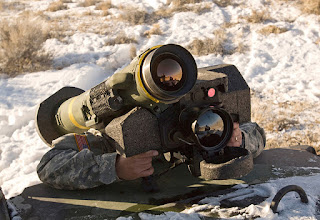The FGM-148 Javelin is an American man-portable fire-and-forget anti-tank missile fielded to replace the M47 Dragon anti-tank missile in US service. It uses an automatic infrared guidance that allows the user to seek cover immediately after launch, as opposed to wired-guided systems, like the Dragon, where the user has to actively guide the weapon throughout the engagement. The Javelin's HEAT warhead is capable of defeating modern tanks by attacking them from above, and is also useful against fortifications in a direct attack flight.
Javelin is a fire-and-forget missile with lock-on before launch and automatic self-guidance. The system takes a top-attack flight profile against armored vehicles (attacking the top armor, which is generally thinner), but can also take a direct-attack mode for use against buildings, targets inside the minimum top-attack engagement range, and targets under obstructions. The missile also has the ability to engage helicopters in the direct attack mode. It can reach a peak altitude of 150 m (500 ft) in top-attack mode and 60 m (190 ft) in direct-fire mode. It is equipped with an imaging infrared seeker. The tandem warhead is fitted with two shaped charges: a precursor warhead to detonate any explosive reactive armor and a primary warhead to penetrate base armor.
The missile is ejected from the launcher so that it reaches a safe distance from the operator before the main rocket motors ignite – a "soft launch arrangement". This makes it harder to identify the launcher; however, back-blast from the launch tube still poses a hazard to nearby personnel. Thanks to this "fire-and-forget" system, the firing team may change their position as soon as the missile has been launched, or prepare to fire on their next target while the first missile is still in the air.
The missile system is most often carried by a two-person team consisting of a gunner and an ammunition bearer, although it can be fired with just one person if necessary. While the gunner aims and fires the missile, the ammo bearer scans for prospective targets, watches for threats, such as enemy vehicles and troops, and ensures that personnel and obstacles are clear of the missile's back blast. More details
